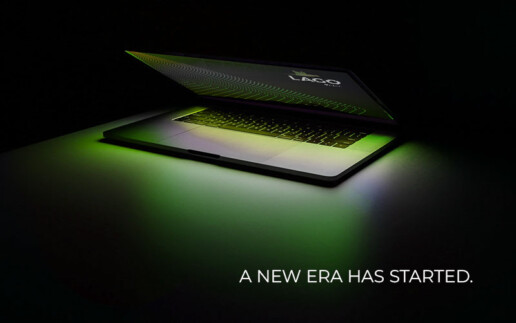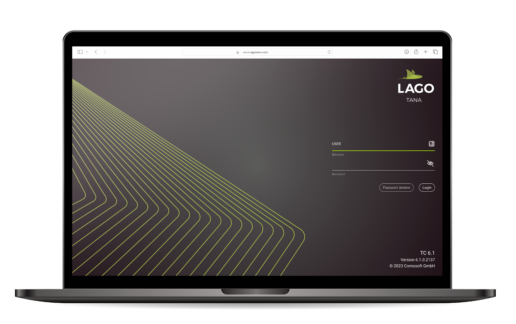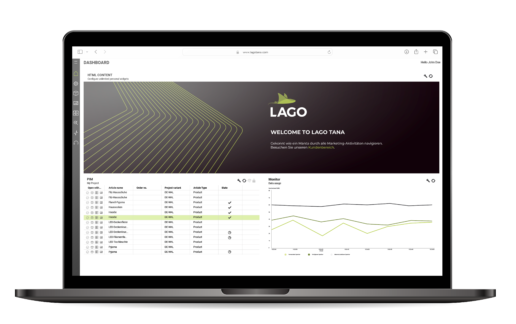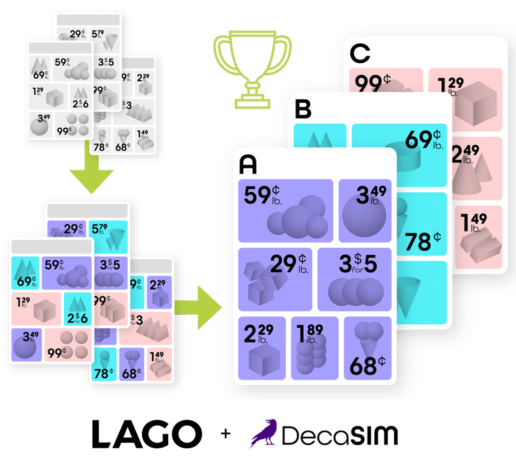5 Retail printing trends you can expect to see in 2024
5 Retail printing trends you can expect to see in 2024
Those claiming that the power of print is waning need only look at the numbers to see how far this is from the truth. Print media is one of the most trusted media channels among consumers, who reportedly trust newspapers and magazines to help make a purchase more than any other type of advertising. In fact, 82 percent of Americans rely on newspaper and magazine advertising as a reliable source.
As a reflection of this trust, the retail print and consumables market is demonstrating significant growth. Looking ahead, the demand for these materials is anticipated to grow between 2023 and 2033 at a compound annual growth rate (CAGR) of 4.5 percent.
Overall, the retail industry is showing signs of growth – and with plenty of innovations in publishing print, retail print marketing is having a moment to carry into the new year.
The U.S. Postal Service recently shared that consumers who receive direct mail from retailers not only purchase 28 percent more items but also spend 28 percent more compared to those who do not receive direct mail marketing materials. Print marketing continues to connect with consumers in fresh, exciting ways. Here are some retail print marketing trends predicted to blaze new trails and lead the way in 2024.
1. A focused effort towards real sustainability
Regarding publishing print marketing materials, retailers are looking for strategies to make their processes more sustainable. This drive toward sustainability includes factors like:
- Limiting carbon footprint and reducing waste production
- Choosing recycled materials for paper, ink cartridges, and other supplies
- Sustainable printers and printing devices
Where is this drive toward sustainability coming from? It’s coming directly from consumers. Recently, an astonishing 84 percent of customers stated that discovering that a brand has poor environmental practices would alienate them from that company – and 55 percent of these customers would even pay more to support an eco-friendly brand than those with less sustainable practices.
Moving into 2024, brands should examine their printing processes to discover how they might make them more sustainable – and how they can share this information with their audience to foster a transparent connection with environmentally-minded consumers.
2. Printing according to demand: Short-run printing
Short-run production and printing on demand are tied closely with a movement toward sustainable publishing. Not only does this limit waste, but it also reduces excess production and costs associated with it. With on-demand printing, retailers are becoming more strategic and printing fewer copies of their printed marketing materials while only producing additional copies as needed.
Short-run printing can be a smarter alternative to larger printing runs when introducing a new product, trying out new content, or even targeting a smaller, niche market with a more focused message. It can also be an effective tool for market research analysis. By including unique promotional codes or QR codes in short-run printing materials, retailers can gather more specific data about how their customers respond to a particular product or marketing initiative.
3. A continued push toward personalisation
Personalised print marketing will continue to be an essential trend moving into 2024 for one primary reason: It works. This highly effective print marketing strategy has proven results. Direct mail print marketing personalised to the recipient generates 135 percent better response rates.
There’s much power in personalisation. Consumers already possess a strong emotional connection to a tangible message they receive and can hold. But when retailers match the impact of direct mail with personalisation through customer data, custom greetings, and product recommendations, it amplifies this connection.
Customers feel valued and prioritised When they get a message from a brand that’s meant specifically for them. Perhaps that’s why 75 percent of millennial-aged consumers share that when they receive personal direct mail, they feel special and there’s something quite powerful in that.
With advances in publishing solutions, personalised printed marketing materials aren’t out of reach. Personalisation can be a simple and affordable way to strengthen relationships between retailers and consumers. It can include customisations for location, industry-based marketing, and even customer retargeting – which was once only financially feasible online.
4. The sensory experience of print
Perhaps one of the most significant assets of a print catalog, magazine, or direct mailer? It’s not online. The typical U.S. consumer will spend a daily average of 4 hours and 25 minutes – or 65 full days – on their phones in 2023. Conversely, Americans keep printed, direct mail advertisements in their home for an average of 17 days – and 41 percent of all Americans look forward to checking the mail daily, most of which consists of advertisements.
A printed catalog is a unique, memorable experience in a world saturated with digital interactions. For this reason, many retailers will continue designing print marketing materials that focus on the tactile experience to interact with consumers’ senses in a way digital media can’t. This strengthens the emotional connection consumers feel toward a particular product or brand.
What do these tactile experiences look like – or rather, feel like? It might be the feel of the paper, with choices like linen or textured paper, or even letterpress printing, engraving, or embossing, raised UV and polymer finishes, or specialty coatings like leather or even paper with a sandy texture. It might also be the added texture, look, and feel of interacting with hand-sewn or high-end binding.
The trend of creating a sensory experience for consumers isn’t limited to the tactile feel of printed materials. Some retailers are looking for ways to reach the other senses, even experimenting with adding scented inks, coatings, and varnishes during the print run. Since the sense of smell connects to emotion and memory, this can be a powerful tool for retailers to delight and surprise their customers and make a lasting impression.
5. Embracing new technologies and augmented realities offline
While not a new trend, including personalized URLs and QR codes to drive customers online and track behavior continues to be popular – but these are not the only ways retailers will leverage technology in their printed marketing campaigns.
Consumers are incredibly excited about the possibility of new technologies like artificial intelligence (AI) and augmented reality (AR); they’re eager to test out these tools and see all the different ways they might be used.
Printed augmented reality features included in these printed campaigns can capture the attention and imagination of consumers, with options to discover a product on the page, then use their phone to get a 360-degree view or detailed look at what this product can do or even how it will look in their home.
AR can enhance the user experience and help customers through their decision-making or buying process by scanning a link on the printed page. It’s important to note that customers in 2023 and 2024 may not be eager to download an app to use these features. Thanks to the introduction of WebAR, however, retailers can still implement AR experiences into their print media.
With WebAR, consumers can access many AR features through their device’s web browser. These web-based AR tools present an incredible opportunity for retailers to build innovative campaigns that merge the digital and physical worlds with interactive content and try-it-before-you-buy-it offers that enrich the entire customer experience in a brand-new way.
Comosoft keeps you ahead of the trends
LAGO by Comosoft is a one-of-a-kind marketing automation tool that revolutionizes the entire collaborative workflow process in real time, making it possible for retailers to store data and digital assets in one secure repository accessible from anywhere. The result is a more efficient publishing process that lets you stay updated on the latest trends. When you manage the entire Digital Asset Management (DAM), Production Information Management (PIM), and publishing process from one place, there’s more time to keep up with the newest innovations.
Comosoft LAGO is an all-in-one marketing production solution fully equipped with both a PIM and DAM solution. It supports your operations with integrated workflow collaboration support, versioning
LAGO TANA Release
LAGO TANA – Explore a whole new version of LAGO!
Improved interface, streamlined features and proven workflows:
With this release Comosoft enters a new era of LAGO versions – Beginning with the name Tana and a new LAGO logo. If you ever happened to have an encounter with a manta ray, our new logo mascot, you met one of the most calm and majestic animals on the planet. The version name Tana refers to the biggest lake in Ethiopia, which is the water mouth of the Blue Nile, and the surrounding prolific reserve.
HIGHLIGHTS
A completely new look and feel of LAGO is a long awaited change and above all reflects the new modern technology behind LAGO TANA. Despite the new UI, LAGO retains the familiar user experience. The most impact will be brought by the flat design and a general brighter appearance of the interface. Calm sections with reduced design elements will help users focus on their tasks.
Better overview, faster access. The new LAGO Dashboard, included in our web client will greet all users upon login and before navigating into one of our various applications.
LAGO Dashboard allows to configure global and personal dashboards. Global dashboards can be shared with user groups to ensure that users of the same group have access to the same information. Optionally users can create their own dashboards. Editing the layout of a dashboard is easily done by simple drag and drop actions.
For the content of the dashboards, various widgets are available, such as a global job list, which allows to directly jump into different application depending on the job (e.g. opening a document directly in LAGO Whiteboard or LAGO Proof). The widget “Search Results”, which is based on search folders contains quick links into the applications (e.g. to directly edit an article shown in a filter). LAGO Dashboard can also be used to distribute information such as announcements or links to other important resources, using the widget “HTML Content”.
For over 20 years, LAGO has been using Adobe Photoshop® to process assets for various use cases, from which the import of assets is the main use case. With more parts of the application moving towards the server and aways from client applications, the usage of Adobe Photoshop® has become challenging for IT departments.
The solution is the LAGO Asset Processor, which is the server-based solution for LAGO Pict with Adobe Photoshop®. LAGO Asset Processor runs on the LAGO Application Server (“LAS”) as a servlet within Apache Tomcat and performs asset processing for import and export purposes without the need of Adobe Photoshop®. It is designed for scalability and allows the setup of multiple instances in multiple Apache Tomcats if needed. It is also possible to assign different tasks to different LAGO Asset Processor instances.
Configuration and management of LAGO Asset Processor is being done within LAGO Admin, where instances, tasks and task configurations (e.g. “Hotfolder” configurations) can be configured. The logging and activity can be viewed within LAGO Monitor. The tasks can be activated and deactivated on the fly without having to restart the LAS.
The LAGO Asset Server within LAGO Pict, including the plugin for Adobe Photoshop® is still available with LAGO TANA. However, asset processing without Adobe Photoshop® is only possible when using the LAGO Asset Processor.
The module “LAGO History” including the corresponding application LAGO History has historically been an application for administrators, which allows to view a history on specific data changes per data entity. For example, showing which user has updated a certain price or article. Due to the potentially massive amount of data changes, end users were not the target audience for LAGO History.
This changes with LAGO TANA, since now we offer customisable reports for which administrators can define which data fields are visible in the report and for the first time allow to combine data from various different entities. This makes it possible to not only show a price change for a certain article, but also to which element that article might be assigned as well as the page on which the price change has happened. Previously this information had to be gathered from several views. In addition, an extended search and filtering is now possible for the data to be shown in the report as well as being able to compress variants. The result are condensed reports that can be viewed by end users.
The customised reports are configured within LAGO Admin and LAGO History. Users can access them directly from the project list of LAGO Whiteboard and even within LAGO Whiteboard itself. When selecting a custom report for a page, only changes for articles and elements assigned to page are shown. When selecting a raster field, only changes for that element and its articles are shown.
The usage of the custom reports in LAGO History requires the module “LAGO History”.
The LAGO article type structure is the backbone of every LAGO installation, especially when using LAGO as the centralised product information management system. As the business of our customers grows and evolves, so does the article type structure. New product ranges are added, others are removed or changed. This can have an impact on the article properties as well and might lead to the situation where article property types need to be consolidated and/or deleted.
The article property types however are used in various places in LAGO, such as document templates, scripts and tables. A deletion of a property type could therefore cause a data loss in the system.
With LAGO TANA the new module “LAGO Property Remapping” allows a remapping of article property types which will remap all references of an article property type to a new one.
Support of Adobe InDesign and Photoshop 2024
LAGO TANA will add the support of Adobe InDesign and Adobe Photoshop 2024.
LAGO Layout: Easy access to placeholder settings and highlights
Changing placeholder settings (e.g. dummy values) within document templates can now be done directly in the placeholder palette instead of having to go the template settings dialog. Moreover, the highlight of placeholders can now be enabled/disabled with a single click with the palette “Annotations”.
LAGO Layout: On-demand update for all placeholders of current document
A new button within the placeholder palette allows to update all placeholders of the document without having to close and reopen the document.
LAGO Layout: Move elements between documents
It is now possible to move elements to other documents within the same project. The elements will be moved including all its details, such as components and assigned articles directly within LAGO Layout and without having to rely on LAGO Whiteboard or LAGO PIM/Explorer.
LAGO Layout: Generate PDF documents for a variants of different projects
For customers that are spreading the page production for one printed publication among different projects it is now possible to generate a PDF per project variant type across multiple projects.
LAGO Layout: Open document template of document
A shortcut is now available within the document palette that allows to open the assigned document template of a selected document.
LAGO DAM: Administrative Tasks
The administrative tasks known from LAGO Pict are now all available within LAGO DAM. This includes functions like completely deleting an asset, cleaning up the database from all logically deleted assets or the re-creation of an FPO/Preview for selected assets.
LAGO DAM: Display of asset properties
Asset properties, which were previously only available in LAGO Layout and the LAGO API are now also visible within LAGO DAM.
LAGO Admin: Default Password Policy
LAGO TANA enforces a new default password policy. All passwords must have at least 10 characters. Two of the same characters in a row are not allowed and the password must be different from the user name. This also applies if no password policy is configured within LAGO and also to all technical users, including the users for database connection. The password policy can be strengthened to be even more restrictive.
This was just an appetizer...
Schedule a demo to discover the high potential of LAGO TANA!
Is your catalog ready for the 2023 holiday shopping season?
Is your catalog ready for the 2023 holiday shopping season?
Consumer spending during the Holiday 2022 season shifted some, returning to more “typical” levels compared to the outsized holiday spending seen in 2020 and 2021, when consumers spent and shopped more – likely as a result of plans, trips, and others celebrations that were stifled by the COVID-19 pandemic.
But in 2023, the economy faces some uncertainty. While holiday consumer spending is expected to stay close to the same figures as last year, engaging with shoppers is more important than ever. What should retail marketers expect – and how can they craft a catalog that meets today’s consumers where they are?
Whether you’re opting to publish a printed copy of your catalog or incorporate a digital catalog into your holiday retail strategy, here are a few considerations to get your seasonal catalog ready.
Incorporate interactive digital content
Digital catalogs are one way that retailers are helping customers dive deeper into their brand, explore their products, and learn more about who they are and what they have to offer.
Digital catalogs are available anywhere and can be published and distributed at a lower cost than paper catalogs, but they also present a unique opportunity for interactive content.
With interactive content, brands can use digital formats to go beyond what’s possible with paper catalogs. This includes elements like:
- Collapsible and expandable sections
- Free-form navigation to jump to specific pages or sections
- Clickable links to product listings and content
- New tabs connecting consumers to even more products, videos, and additional content
Some brands are exploring what’s possible with this interactive content. Within SteinMart’s digital catalog, every page is organized like its own individual site that organizes products by style groups, divided up by collections and even life events to let shoppers interact with the retailer exactly how they want.
- The clickable header at the top of every page allows readers to jump to different departments and categories with one tap.
- The bottom of each page includes a call to action to expand the shopping experience and browse a related category, page, or department.
There are so many more opportunities available to engage with consumers via a digital catalog that go just beyond the page – and the holiday shopping season is a perfect opportunity to anticipate customer needs, offer purchasing suggestions, and drive overall brand engagement.
Encourage engagement with QR codes
QR codes (quick-response codes) were emerging as the “next big thing” in 2011 when 14 million Americans started using their mobile devices to pick up links on the go, but then this trend started to slow down – and even die off, according to some reports. This is because, at the time, QR codes required secondary scanner apps, making the real-life application of this technology clunky at best.
Now, smartphones have built-in QR scanning capabilities, streamlining the process and removing the unnecessary steps of downloading and opening a third-party application. Particularly after the pandemic, QR code usage is on the rise as a fast way to share information and a hands-free option instead of restaurant menus or printed handouts.
In 2021, 75.8 million smartphone users in the U.S. scanned a QR code on their mobile devices, and this figure is anticipated to climb to 99.5 million American smartphone users by 2025.
The main things consumers are using these codes for currently include accessing promotional offers, but by 2024 or 2025, QR codes will also be used for things like accessing payment portals and more.
How should retailers think about using QR codes in their Holiday 2023 catalogs?
- To encourage readers to download the retailer’s app in both print and digital media (including videos and images)
- To enhance the reader experience and encourage them to learn more about a product, read a story about a product user, case study, or unique use-case scenario
- To include “Santa tags” as some retailers have done, and include a scannable QR code with any purchase to link gift recipients to a personalized audio message recorded by the gift-giver
- To share step-by-step instructions (for gifted furniture or complex, multi-part toys, for example)
- To view exclusive, holiday-themed video content
- To unlock a promotional code or sign up for promotional emails
Find inspiration for social interaction
In 2022, the holiday shopping season saw increased commerce coming in via social channels. This is because more consumers are discovering brands and products – and making purchases – through social media ads and social content. In fact, during last year’s holiday season, traffic referrals from social media content rose by 23 percent, which accounted for 12 percent of all mobile eCommerce traffic.
This trend won’t likely be slowing for the 2023 season, and retailers should look to social media as a significant investment to bring new traffic to their digital stores. Social media is a major player in connecting with new customers and driving discovery.
In particular, the social platform TikTok is a big reason social media-based sales are expected to grow during the 2023 holiday shopping season. Many target audiences contribute to this growth by jumping on the #TikTokmademebuyit trend and making some products go viral. Now that TikTok has expanded into selling, social commerce is anticipated to grow by 29.8 percent in 2023.
Lifestyle and consumer brands should use this time to find strategies to maximize their social media reach via their catalogs and help drive conversions. Social media channels like Instagram, Facebook, and TikTok can amplify retail brands through strategies like in-app live-streamed shopping content and links to digital product catalogs to bring catalogs and social media together to connect with consumers.
A strong connection to digital assets and product inventory
Especially as more consumers prefer to use their mobile devices for browsing and purchasing, dynamic digital catalogs will become increasingly important to the holiday shopping season. In fact, across the retail industry, mobile devices account for 77 percent of all traffic during the peak shopping season in 2022, which is a 4 percent increase over the previous year and 65 percent of all buying sessions, up 5 percent from 2021.
This means catalogs should be stocked with the most effective digital assets and the latest, most accurate product information to provide consumers with the best online shopping experience.
What does this mean? Digital Asset Management (DAM) and Product Information Management (PIM) solutions are more critical than ever in the intersection of digital catalogs, eCommerce, and mobile shopping.
Retailers can use DAM tools to prep their catalogs by tracking metadata on compelling images, videos, and other digital assets that can help make the most impact for print and online catalogs. They can also use a DAM solution to create, review, publish, and share holiday-specific assets and media, manage versioning, streamline workflows, and simplify and transparent communication regarding peak season.
As for PIM solutions? These can keep online catalogs automatically updated with the latest product information and marketing data with product identifiers, titles, descriptions, images, pricing, quantities, and more.
Tackle the holiday 2023 season head-on with LAGO
LAGO by Comosoft is the ultimate tool in preparing for the busy holiday season. Why? Because this PIM DAM solution has been intentionally engineered to make publishing – and multichannel marketing in general – easier and more potent than ever before.
Creating catalogs is a breeze with LAGO, which updates drafts in real time as assets are updated and revised. Layouts, edits, and versioning workflows are stress-free, as there’s never a question about who’s responsible for completing a task or which assets are licensed, up-to-date, and available for particular campaigns.
What’s more, you can use LAGO to create your free-form and dynamic digital catalog for the holiday season, then connect it directly to the shared PIM system to align your eCommerce initiatives with your marketing campaigns for a smooth workflow and a seamless customer experience.
Ready to learn more about how you can revolutionize your Holiday 2023 catalog campaign? Request a demo today!
Optimising promo selection with AI to increase profit
Optimising promo selection with AI to increase profit
Discover how AI can enable grocery retailers to plan promotions that consider seasonality, unique pricing, and product data to engage customers, increase sales, and grow profits.
Add Intelligence & Harvest Profit
Recent advances in artificial intelligence (AI) brought to market by Chat-GPT and GPT-3 is a clear signal that AI is a viable technology for retail marketing departments. Integrated with Comosoft LAGO, the AI-based DecaSIM promotion ranking tool adds an additional layer of intelligence to the existing planning process, adding measurably to the impact of the weekly ad and on store profitability.
Implementing DecaSIM’s AI solution is easy. Our technology integrates seamlessly with existing processes and infrastructure. To demonstrate this, a leading regional grocer implemented a live test and generated positive returns from week one. By optimizing which promos to feature in its advertising, their customers were more engaged with the offers, which increased weekly sales and grew profits (EBITDA) by 8%.
Customise promos on undiscovered shopping patterns
Retail price promotions serve as a catalyst for customer engagement, loyalty rewards, and shaping purchasing behaviors. However, as promotional strategies become more intricate, the challenge lies in leveraging these discounts to drive incremental shopping trips.
Customer behavior is complex and in the realm of promotions there are many potential unintended consequences. For example, different promotions often cannibalize one another by appealing to the same audience. The net effect can be a zero increase in customer engagement. In today’s inflationary environment, this can result in a missed opportunity to increase shopping trips from the growing audience of value-conscious shoppers.
Comosoft LAGO and DecaSIM work together leveraging DecaSIM’s advanced retail AI to create a predictive model that simulates the response of your shoppers to different promotional strategies. Through this innovative AI technology, we can discern the most potent promotions for drawing in customers. Our integrated solution adeptly pinpoints the promotions that resonate most with your price-conscious shoppers, fostering heightened engagement, increased sales, and amplified profits for our valued retail partners.
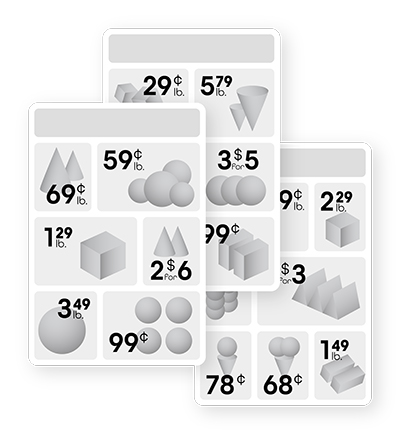
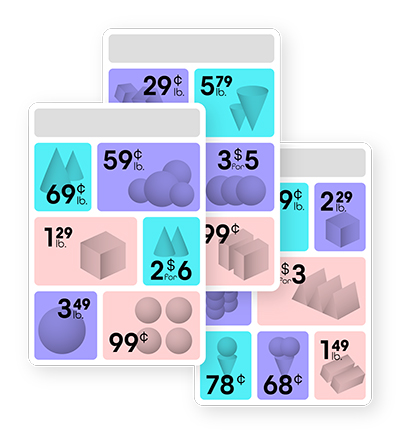
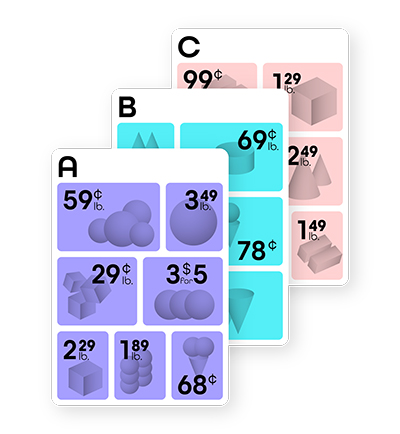
Putting theory into practice
A 300+ store regional grocer selected a region and, using the Comosoft LAGO system, created a specific version of its weekly ad circular to optimize during a ten-week test period. Each upcoming week‘s promotional plan was run through the DecaSIM optimizer during the test. The results of this analysis were then used to select which items to feature on each page of the circular.
The test region consisted of 104 stores. An additional control region was created with 65 stores. To evaluate the intervention, the percentage of shoppers who engaged with the promos featured in the weekly circular was measured in the test region stores, and these results were compared to those from the control region stores. Total store sales in the test and control region stores were monitored carefully for changes.
Results show increased performance on all measures
Conducting these tests, the retailer established a set of measures to evaluate the performance of the recommendations, increased engagement with promos, impact on total store sales, and store profits. On every metric, the results showed a positive increase versus the control.
Download the full case study here!
Fill out the contact form and receive an e-mail with the link to download the case study. If you don’t receive an e-mail from us, please check your spam folder.
Belcorp: The Beautiful Message
Belcorp: The Beautiful Message
How a multinational beauty company manages its vast array of product information to create (and future-proof) its vital marketing efforts.
The modern beauty industry is complex indeed. Companies in this highly competitive arena succeed only when they connect their many products to the needs and desires of ordinary people. These are consumers looking for a brand they can trust and rely upon when it comes to their own self-image. Every product is a personal connection, not just a commodity. One such company – Belcorp – has successfully made this connection with its customers for years. But in today’s multichannel environment, that also poses an ongoing marketing challenge.
When a beauty company offers multiple products, sells to customers in many countries, and supports a large, knowledgeable, in-person sales organization, it must have a strong, agile marketing presence. It must maintain a complex array of printed catalogs and other targeted marketing materials and plan for the same level of complexity in its digital media. This is a closer look at how Belcorp is meeting the challenge today – and planning for success in the future.
A history of personal connection
Belcorp was founded over fifty years ago, dedicated to the ideal of promoting beauty as a way to achieve personal fulfillment. It uses a direct, in-person sales model – a vast network of consultants throughout the Americas – to connect with individual customers. This go-to-market strategy has created a positive experience for many, helping thousands of women achieve economic independence. Belcorp CEO Erika Herrero notes, “day by day, we are transforming the lives of thousands of women and their families.” But the company’s purpose transcends the economic results. “We promote beauty to achieve personal fulfillment,” says Belcorp spokeswoman Joy Chion Li.
“We inspire each person to give their best so that they and those around them achieve the extraordinary.”
This lofty goal has guided the company to remarkable success. Since its founding in 1968, Belcorp has grown its in-person sales network to over 850 thousand consultants in 13 countries in the Americas. In addition, the company operates 54 physical retail locations, and in 2016 it launched a robust e-commerce presence.
Today, Belcorp has three distinct but interrelated product lines. The Ésika line features an array of high-quality makeup, perfumes, personal care products, and jewelry – all designed to “inspire women to own their confidence and celebrate their power.” The L’BEL brand combines beauty, health, and technology in the form of personal hygiene and skincare products for both women and men. The third line, Cyzone, offers high-quality, affordable beauty products designed for younger women.
In addition to its product lines’ impressive breadth and scope, Belcorp’s products reflect its commitment to sustainable development and manufacturing, including certification of its cruelty-free testing requirements. This is all carefully managed, along with the data related to each individual product.
Download the full case study here!
Fill out the contact form and receive an e-mail with the link to download the case study. If you don’t receive an e-mail from us, please check your spam folder.
The Planning Paradox
The Planning Paradox*: How to Effectively Plan Multichannel Marketing Campaigns
*The uncertainty of early-stage decision-making characterises the paradox of project planning. To plan appropriately, stakeholders must make early decisions to keep things moving but might not initially have the knowledge (or data). More information (or data) might be available later in the production process, but the decisions made in these later stages might be less important for its success or would be too late. That concept is the paradox.
Large, national retailers – and even smaller, regional ones – often must cope with several logistical and market challenges. One of these is the rapid proliferation of media channels. In each one, they must establish a good relationship with current and potential customers, preserving the retailer’s brand without sacrificing accuracy or time-to-market with each campaign.
Before digital, planning and executing an ad campaign or catalog took hard work and creativity. Now, the work is exponentially more complex, thanks to the demands of digital, mobile, and especially social media platforms. A single, well-planned, branded campaign must now feed multiple outputs – each with its own peculiar attributes and requirements. Each campaign also must be strategic, featuring products with ample profit margins, dependable sales histories, high brand recognition, and adequate inventory in the region(s) where they are promoted.
All of these particulars are represented as distinct pieces of data. Some are contained in massive Product Information Management (PIM) systems. Others, like product images and descriptions, are housed in Digital Asset Management (DAM) systems. Still, others are found in separate, often proprietary databases or systems for pricing, inventory management, sales history, social media management, and content marketing. Sometimes, these databases can be more or less related or combined. But all too often, they are separate “silos” of information – rich in potential but difficult to handle efficiently and still leave room for creativity.
Putting Marketing Managers in charge
Marketing managers and directors have enormous responsibilities for creating profitable campaigns. To do so requires more than good instincts. They must also have a solid grasp of the data and how it relates to the campaign. For example, when planning a multi-region campaign, it’s vital to know which products have the greatest sales and profit potential in each region and their stock availability in those regions. With little time to spare for research, the best alternative is to let the data tell you which products are best. In the marketing ballgame, instinct counts, but data makes the rules.
The problem is that most data is often not easily accessible – or easy to visualize. What is needed most is a comprehensive integration of all that product data, plus the ability to transmit a marketing manager’s decision directly to those designing the print or digital campaign output.
In previous columns, we’ve discussed how Comosoft LAGO provides such an integrated marketing workflow. However, for those responsible for creating campaigns out of all that data, we must take a closer look at LAGO’s approach to planning.
Nearly every modern business plan begins with a brainstorming or concept overview process. The universal metaphor for this is the ordinary whiteboard. In this century, physical whiteboards have been supplanted by digital ones, allowing multiple parties to collaborate on visual representations of an idea. LAGO provides such a tool for marketing managers but with a crucial difference. In addition to freeform notetaking and review visualization, the LAGO whiteboard is truly connected to the retailer’s integrated data.
During the planning phase of a campaign, the manager or director can easily find the products best suited to the retailer’s bottom line. Once selected and placed on the whiteboard layout, the planner’s decision includes the product’s related PIM, DAM, and pricing information. This decision also sets a reliable reporting framework in motion, allowing the marketing manager to track a product’s success in a specific campaign and learn how to improve that performance over time. LAGO’s visual interface gives the planner the best of both worlds – conceptual awareness of a product’s appearance and attributes PLUS a frictionless connection to reliable product data.
Making the handoff easy
Once a campaign is mapped out with the LAGO whiteboard, an Adobe InDesign template is generated automatically, giving the production design department a head start in creating the output. The template includes each page’s product placement decisions, complete with links to the related PIM, DAM, and other data sources. Each designer is freed from the burden of tracking down all that data or, worse, replicating all the marketing manager’s choices. They are free to do what they do best – design.
The connection between layout and data is preserved using a LAGO plugin for InDesign. If something changes in the data, such as an updated image or product specifications, the layout is updated automatically. The data flow is also bi-directional. When a designer makes a substantial change – via a documented approval process – the marketing manager is aware of it.
One of the bigger challenges for larger retailers is making custom or regional versions of each catalog or other campaign output. LAGO makes this process simple, using the original layout (as conceived by the marketing manager) as a “master” version. Unlimited versions may then be created, preserving the piece’s universal elements (and the brand identity) while allowing the substitution of regionally relevant products or offers. Each version remains relevant to the overall campaign while also allowing each location to have the ability to optimize for their market.
In addition, LAGO also gives marketing campaigns an effective way to replicate a campaign across multiple channels. The data, images, and presentation created by the original designer can be transmitted automatically to the retailer’s web, mobile app, or social media groups – allowing them to populate all marketing channels rapidly with the latest campaign data.
Plans in motion
Collaboration is always the key to a successful multichannel campaign. But the effort is broader than savvy marketing, creative, and production teams. Their tools must be smart as well. With Comosoft LAGO as the expert tool set, such a collaborative workflow is genuinely possible.
Retailers are automating their weekly circular production
How retailers are automating their weekly circular production and do more with less
The weekly circular has long been a staple marketing and advertising tool for grocery chains and other large retailers. To cope with the disruptions of digital media, retailers have experimented with various ways to cut costs, sometimes discontinuing the printed versions of circulars (especially as newspaper inserts) only to bring them back in other ways. Recently, a national grocery retailer paused the printed versions of their weekly ads but then brought them back as regular mailers, with targeted promotions and QR codes to take customers to sale items on the website.
There are good reasons why the weekly circular – in print or digital formats – is an enduring tool for marketing and advertising directors. As Motley Fool writer Maurie Backman noted in her May 2023 column, using the circular as a five-minute research guide for shopping lists can save consumers significant amounts of money – a worthwhile pursuit during high inflation. And, if the circular is well-designed (and accurate), it also serves as a familiar, brand-reinforcing weekly reminder to consumers.
A complex process
Weekly circular ads and flyers (printed and digital) are the lifeblood of a retailer’s marketing program. The larger the retailer and its inventory of products, the more challenging it is to produce compelling and accurate flyers using SKU data that promote high-margin products. Creating multiple versions of that same flyer that support various regions and markets is even more challenging.
As creative services and production managers know, creating an effective weekly circular is complex and difficult. It was always challenging, but with the growth of digital, retailers are under enormous pressure to deliver more content across an increasing number of platforms. By using the weekly circular as a starting point, they can begin to fill that need – but only if they have the right processes and workflows to handle the flood of activity it requires. And they must do so, very often, using overstretched human resources.
The circular involves multiple departments and individuals, each racing against a weekly deadline and coping with product management details, rapid and time-sensitive changes in the information, design localization and versioning, and conversion to digital and social media channels. This process is complicated even further by the fact that product statement from multiple manufacturers is stored in several different databases, starting with their product information management (or PIM system), digital asset management (or DAM system), and other data sources.
If any of these processes must be done manually, then retailers cannot reasonably expect to keep up. They will risk enormous gaps in their marketing content mandate – not to mention the risk of costly errors in the material produced. Automation is the secret to “doing more with less”, but that is hard to do haphazardly or piecemeal. Facing the continuous onslaught of activity that weekly circulars represent, retailers need a global solution.
An elegant solution
Comosoft’s LAGO represents the ideal solution to this perplexing problem for large retailers, including major grocery chains. By taking a holistic approach to data management, campaign planning, and media production, LAGO gives retailers the luxury of automation while giving marketing managers and production designers the freedom to innovate.
The LAGO process begins with a plan. Retail product line and marketing managers create a campaign strategy based on an integrated approach to product information (PIM), product images, logos, descriptions (DAM), and other connected data sources – all coordinated with a digital whiteboard interface. Products with higher margins or known popularity can be featured, along with a mix of the retailer’s other offerings. Sale pricing is based on real-world business goals and solid data.
After the campaign is planned, it gets transmitted to the design team through InDesign templates automatically. These have the campaign’s featured products in place and real-time connections to all their related PIM and DAM information. Designers are freed from the need to track down all that data and can focus on designing the finished product. When multiple regional versions are required, the design team can create these easily, using the base circular as the “master version” and creating regional variants according to that region or branch manager’s priorities.
Other time-consuming manual tasks are highly automated as well. LAGO provides an efficient, collaborative approach to proofing and approvals, sending digital proofs automatically to the right decision makers and returning their feedback to the design and production teams, who can send the finished, multi-version result to the proper print service providers anywhere in the country.
The automation does not stop at print, however. Data used to create a circular in LAGO can be automatically sent to the retailer’s website or mobile app, even on a regional level, satisfying today’s shopper’s growing need for up-to-date information on multiple media channels.
As LAGO users have discovered, there are ways to reimagine the printed circular. QR Codes, which have seen a resurgence since the pandemic, can easily be integrated into the LAGO workflow, typically as part of the retailer’s existing DAM system. Just as a marketing manager and design team can easily specify a product photo, they can also include a QR code for that product. When the printed circular comes in the mail, users can quickly go to that product’s sale landing page, genuinely integrating the print and online experience.
“Doing more with less” is much more than a catchphrase. With advanced workflows from LAGO, retailers can make it a profitable reality.
The 9 biggest trends in print publishing
The 9 biggest trends in print publishing
Catalogs, print media, and direct mail flyers can be powerful tools to connect with your target audience. After all:
- Print marketing boasts a recall rate between 70 and 80 percent higher than digital advertising.
- Marketing emails have an average response rate of 0.1 percent – but direct mail has a response rate of 4.9 percent.
Even in our digital economy, print marketing is incredibly effective. Around 44 percent of consumers will visit a company’s website after receiving a direct mailer, catalog, or magazine.
Print marketing, magazines, and catalogs are making a comeback in 2023 and beyond, but the strategies for these formats look very different than they did years ago. Here’s an inside look at what trends are rising to the top and catching the eye of today’s consumers.
1. Sewn binding
Brands looking to make their mark are finding significant differentiation in the look and feel of their catalogs and print media by opting for all kinds of binding.
On the one hand, some brands use hand-sewn binding to evoke a feeling of something unique and handcrafted; recipients of these catalogs can get the sense that they are lucky to have come across something so rare. On the other hand, a sewn binding feels as though artisans handled it and gives off the sense of the culture and history of a brand. In many cases, this can help establish a strong connection between the brand and the consumer. Post Press Magazine even suggests selecting contrasting threads to highlight this feature.
Brands wishing to share their unique history, artistry, and attention to detail are choosing sewn binding more and more frequently lately.
2. Upscale binding
Conversely, other brands are choosing high-end binding. With this option, their print media can feel just as memorable. Instead of the handcrafted feel of sewn binding, high-end binding makes a catalog or printed marketing magazine feel like a coffee table book; it’s a piece that’s meant to be savored and cherished.
For this kind of hard-case binding, the case might be covered in some material or even embellished with hot foil stamping. Another popular binding trend making the rounds today is Swiss binding, in which the text block is glued to the outside back cover so that, from the outside, the catalog looks like a casebound book. Upon opening a Swiss-bound magazine, the spine is revealed and may be sewn or saddle stitched.
For brands looking to put luxury on display, high-end binding options are an extra element to make the tactile experience of leafing through a catalog or magazine feel more personal to the brand identity.
3. Personalization
An increasing number of consumers crave personalization from their user experiences, marketing, digital environments, and more. Forbes shared that 80 percent of today’s consumers only shop with brands that provide a personalized experience.
But personalization in catalogs, magazines, and print media? Is that really happening?
It is – at a quickening pace. Personalized content is more important than ever before. This kind of custom printing means having the solutions to craft countless customized experiences in the same publication. That means:
- Understanding your audience’s needs, wants, and priorities, as well as what they find motivating or engaging.
- Having the tools on hand to keep your workflow and collaboration flexible and agile while keeping track of customer needs as they evolve.
- Creating a magazine with the experience in mind, balancing large-scale appeal with personal touches.
Post Press Magazine quickly points out that nobody wants to receive irrelevant marketing materials like coupons, catalogs, or emails. Personalization today enables brands to take custom printing beyond just mail merges with solutions like variable data printing, supported by a robust pool of customer data and detailed analytics.
4. Adding some luster with foil
Many brands lately are choosing to enhance their catalogs and magazines with the metallic sheen of foil stamping and printing. This trendy option can make catalogs feel sleek, modern, and upscale.
You’re not wrong if you feel like you’ve seen shimmer and foil for a while now. But, of course, foil stamping has been popular for quite some time. Still, with new print technologies emerging and becoming more accessible, a whole new range of options is available to enhance magazines and catalogs with a touch of extra luster.
Thanks to these new print technologies, popularity and interest in this glamorous look have been resurgent. Foil printing and stamping options include hot and cold foil, metalized substrates, and digital foil.
The result? No matter your budget or price point, you can add an element of sheen and shimmer to your next printing to make a strong brand statement and catch the eye of your target audience.
5. Offline media to invite your audiences online
There’s nothing like the feeling of leafing through an artfully designed magazine or catalog, but what’s the next step? Tactile experiences are meaningful, but how can you continue to keep your audiences engaged?
Print catalogs and magazines can significantly impact sales—even for eCommerce brands. In fact, 57 percent of consumers prefer print catalogs over their digital counterparts. Moreover, 69 percent of consumers have paged through a printed catalog for information before purchasing online.
In other words, print media is still relevant to boosting sales in our digital marketplace. Even so, magazines and catalogs today are essential tools brands can use to invite their customers online, where you can collect consumer data, reinvigorate marketing efforts, and help solve their problems in new ways. Some of the trend’s brands are using to encourage their catalog-loving customers to go online include:
- QR codes to take customers to a direct page or even make a direct purchase
- Image recognition apps to pull up product information without QR codes
- Including website URLs and links on each page
- Printing contact information and website information clearly on the back cover
6. Telling a story
How can you get customers to return to a magazine or catalog, flip through the pages again, and savor every page? By taking a storytelling approach.
Household names like NASA, GoPro, Airbnb, and Bonobos use visual storytelling to build an emotional connection with their audiences. Bonobos, in particular, has leaned into the storytelling surrounding the lifestyle of their brand, centering their storytelling around golf.
After sharing the design philosophy and love for the heritage of gold early in the catalog, the following pages are all devoted to linking the golf lifestyle to their clothing, even shooting the photos in an actual golf club and displaying images of active golf swings from page to page.
The result? Their customers see the product in action. They experience the story behind the clothes and the life they could live while wearing them, not just the clothes themselves.
7. Becoming one with nature
In a time when 75 percent of millennials say that they would pay more for a brand that centers around sustainability, an increasing number of brands are putting their efforts on display, making nature a core element of their print media messaging.
This means wood grain texture, earthy colors, and natural elements are heavily incorporated into the design, celebrating and appreciating the planet. This all-natural trend is showing up everywhere, from interior design to fashion and merchandising, and the popularity of this concept is showing up in print and catalog marketing.
Not only does the prevalence of natural elements suggest a commitment to sustainability and love for the earth, but these elements are also timeless, elegant, and aspirational for true nature lovers and would-be outdoorsy types alike.
8. Unique discounts from cover to cover
Emails and newsletters are still popular ways to market to customers, target new audiences, and track consumer activities. Still, marketers are finding ways to follow behaviors and appeal to deal-seeking shoppers through catalogs and magazines.
To get the most out of catalogs and magazines, marketers place unique discount codes within the pages of their print media. The benefits are twofold:
- They motivate casual shoppers to make a purchase online.
- They gather invaluable marketing information to discover their marketing materials’ performance.
This strategy is a great way to discern what actions real customers are taking and their preferences. With this direct feedback, you can make data-driven predictions about what products and services your customers are interested in.
9. High-Quality paper
When promoting your brand, your choices are a statement of your focus on quality, so your brand stands out from the competition. These choices include everything from the quality of your logo and pictures, ensuring they aren’t blurry and pixelated, to how print media is bound. And when it comes to print, quality also includes your choice of paper: the texture, weight, feel, and sheen of it.
It’s estimated that the average American consumer receives 41 pounds of unsolicited mail every year – per person. The result of all this mail? Unfortunately, these print catalogs and magazines feel like an afterthought and are often discarded or recycled immediately. But quality print media speaks to the quality of the brand. It feels good and inspires recipients to flip through the pages more.
Comosoft: Keeping you current
LAGO by Comosoft is a marketing automation tool that makes it simpler than ever to foster a collaborative workflow (in real-time), store data and assets in a single, secure repository accessible from anywhere, and manage everything from print marketing to point-of-sale in the same place.
Comosoft LAGO is an inclusive marketing production solution with integrated Product Information Management (PIM) and Digital Asset Management (DAM) systems. In addition, it comes complete with integrated workflow collaboration support, versioning optimization, and a proofing system.
With LAGO, creating print magazines and catalogs is easy and efficient, saving you time and money that you can invest in things like paper quality, foil printing, binding, and more. In addition, by collaborating in real-time, your media can be as up to date as desired, empowering you to stay ahead of the latest print marketing trends.
Growing e-commerce with print? Yes, please.
Growing e-commerce with print?
Yes, please.
Yes, please.
Life without e-commerce is inconceivable today. Even in a retail store or shopping mall, it’s common to reach for our phones to compare prices or check on the availability of something in a different color or size. Brick-and-mortar store managers may resent it, but mobile e-commerce is here to stay.
But it’s also no surprise that retailers continue evolving their marketing strategies, supporting a consistent customer experience across every channel. Both brand identity and product promotion details must be consistent, regardless of the device or medium is used. That requirement is essential to marketing and advertising directors – and the production and creative managers who get the job done – whenever they coordinate retail campaigns in their print and mobile shopping iterations.
Faced with the need to optimize marketing spending, retailers are expanding and enhancing their traditional print advertising strategy. Weekly circulars and product catalogs are no longer just standalone elements. They now must be totally in sync with their mobile shopping app counterparts. All the elements of a featured product – images, brand elements, even color and size choices – must be consistent across every channel and customer experience, even down to the local store level.
Even more critical, the printed elements of a campaign must also serve as a “launching pad” for the mobile e-commerce experience. Catalogs, circulars, and flyers can no longer be merely informative and persuasive displays. They must also make it easy for customers to order products on the spot. Of course, the easiest way to do that is to print a QR Code next to the featured product, but doing so efficiently can be challenging.
It’s all in the data
QR Codes can be generated easily for each product SKU and then stored, like any other image, in a Digital Asset Management or DAM system. Each code can take the catalog or flyer reader directly to the retailer’s e-commerce ordering page for that specific product, dramatically shortening the sales cycle and providing immediate feedback on the print campaign’s effectiveness.
But while the print-to-e-commerce-purchase cycle is easy to understand, it can be difficult to implement on a large scale. With dozens or hundreds of SKUs in every print marketing campaign, plus the need for multiple regional versions of each printed piece, it takes a lot of work to keep all that DAM and Product Information Management (PIM) data straight. It’s also a challenge for designers to manually assemble all that data and imagery into a single ad—not to mention a catalog or flyer featuring multiple products.
Fortunately, the LAGO system was designed to do precisely that. Using an InDesign plugin, designers can easily and automatically assemble all the PIM and DAM elements related to any SKU in the retailer’s marketing campaign, focusing their time on designing the catalog or flyer—and not hunting for all the pieces. One of those “pieces” in the DAM system can easily be the QR Code for that SKU. Thus, the designer doesn’t have to test or worry about whether the QR Code is correct. They focus on design.
LAGO can do even more than that, of course. For example, if a retailer needs to create different versions of a piece with regional price or product variations, doing so is simple and effective. And because LAGO’s digital output supports versioned pages, including product hotspots and QR Codes, even complex, multi-region retailers can easily transition their print campaigns to digital, creating content for multiple channels with data that increasingly resides in the cloud.
On beyond print
Once a print layout is created in LAGO – for a single catalog or multiple regional versions—the journey is not over. All the related PIM and DAM data can also populate e-commerce websites and mobile shopping apps. During the layout process, designers can designate product hotspots, which are not used in the printed output, naturally, which allow the online output to contain live links to the e-commerce ordering portal, to use just one example.
Product hotspots have many other uses, including triggering multiple image galleries, special offer overlays, size and color variations, alternate text descriptions, and more. These elements have the advantage of being connected to a product’s PIM and DAM data, so the designer need not spend hours figuring out how the online version will behave.
The necessary PIM, DAM, and other data to required accomplish these tasks are increasingly located not in local servers but in the cloud. This is especially true for large, multi-region retailers but is also becoming the norm for marketing departments in every industry. Fortunately, LAGO and its components can easily be cloud-based, offering IT departments increased flexibility and scalability.
Once the main layout is created, LAGO can export the results to multiple formats, each appropriate to the required print or online channel. In addition, it can automatically generate XML and JPEG/PDF for selected pages based on the desired multichannel output workflow. With so many channels in constant need of consistent, well-formed content, LAGO has proven to be a reliable workhorse for retail marketing and advertising operations.
Finally, no discussion of multichannel marketing would be complete without mentioning the growing arena of dedicated retail shopping apps. Like all other online channels, shopping apps need to be constantly updated with the latest product information and marketing campaigns. Fortunately, LAGO can export all campaign data directly, including regional variations, to populate the retailer’s own website or mobile app, creating product location and pricing aids based on LAGO’s versioning capability. One such retailer, home improvement chain Lowe’s, used the LAGO system to create its multi-version printed flyers and, by exporting the resulting campaign data to third-party developer FLIPP, allowed them to create an extremely precise and effective mobile shopping app.
Conclusions
Print and online are not mutually exclusive, either-or choices for marketing and advertising directors and their teams. Used well, print is the perfect vehicle for enhancing and extending the interactive online shopping experience. By using the LAGO system, well-designed print output will attract and motivate shoppers and lead them to buy more frequently online – growing your e-commerce presence exponentially.
How to advance ad production and increase creativity in Adobe InDesign
How to advance ad production and increase creativity in Adobe InDesign
As every InDesign user is aware, it takes a lot of effort to produce high-quality advertising pieces. It’s partly about the tools we use. Since its introduction over twenty-two years ago, Adobe has made its flagship page layout application more powerful. Even with InDesign’s built-in potential for automation, not every design team can keep up with the ever-increasing demands of high-volume production.
You’ll notice we emphasized the word “potential.” Under the hood, InDesign is remarkably open to automatic interaction with various other systems – including product information (PIM) and digital asset management (DAM) systems. But having that ability and using it are two very different things. They require a robust, smart connection between the data and the InDesign workflow.
Take the creation of a “simple” ad, for example. The process involves many different components, even for a single, featured product. First, there are product images and descriptive text to select and modify. Next are essential brand elements, campaign-specific copy and directives, relevant specifications (sizes, colors, etc.), and pricing details. Finally, the designer must gather all of these, ensure they are the latest and most accurate versions of the data, and then apply their creative abilities to synthesize it into a compelling advertisement.
This manual process has been a challenge for creative teams since the early days of modern advertising. But things have not gotten easier. Add to the above list the need to produce multiple ads for both print and online channels – not only for single products but for an array of products in each campaign. Our data sources have become more extensive and detailed, so the need for custom versions of everything has expanded exponentially. Different versions are required for different parts of the country, different languages or age demographics, and even different individuals! Adobe InDesign has the power to do most of the individual, creative tasks of an ad campaign. But what InDesign cannot do by itself is increase the one thing in short supply for every design and production team on the planet – the time to get everything done.
Solving the Time Problem
Of course, the answer is to automate the ad production process but to do so without damaging the creative heart of the team. In today’s crowded, multichannel media environment, being visually innovative is more important than ever. Ads must not only be accurate, but they must also stand out from the crowd and influence potential customers. Unfortunately, with the pressure of doing so many ads on so many platforms, without losing the essential creative “spark,” many production and creative services managers may feel a bit like Sisyphus – forever rolling bounders uphill just to keep their campaigns going.
Workflow automation must do more than simplify a handful of repetitive tasks to be effective and recover all that lost time. For ad workflows, in particular, automation must take a holistic approach, from the initial campaign planning stages through InDesign production, proofing, print output, and repurposing for digital channels. In effect, ad design and production teams must become agile. It all begins with tight integration a company’s DAM and PIM data sources and InDesign.
Working With Adobe
Decades ago, Comosoft became an Adobe development partner in what is now known as the Adobe Exchange Program, a long-standing effort to work with third parties to create extensions or “plugins” for Adobe software. The program takes advantage of the inherently open software model to solve complex problems facing marketing production teams. In this case, the two companies co-developed the LAGO Layout plugin for InDesign.
LAGO Layout adds a new set of controls to each InDesign installation. One of these controls connects the designer directly to the company’s PIM, DAM, and other data sources, allowing the user to access all the data and images for a particular SKU, eliminating the need to search for elements to complete an ad. The connection is also bi-directional. If something in the PIM or DAM changes (such as an updated product photo), the ad layout is automatically updated until the final output.
The link between data and InDesign is only part of the picture. For example, in the planning stage of a campaign, product marketing teams can use LAGO’s whiteboarding function to choose the optimum product mix based on factors such as profit margin and sales history to sketch the basic visual message. LAGO automatically uses this step to create a preliminary InDesign template – with all the requisite PIM and DAM information included by SKU. The designer then automatically receives an error-free starting point for the ad so that they can devote their energy to the creative process.
Going Above and Beyond
The LAGO system also automates the review and approval process, using Adobe InDesign Server to generate proofs automatically for online approval. When a proof is created, the appropriate parties are notified automatically, and their notes and corrections are sent back to the designer immediately.
LAGO can also generate multiple regional or demographic versions, automatically use new “base” templates that allow designers to customize each version easily without re-creating common elements. Each version can be automatically sent to the appropriate printing facility or agency when finished.
Finally, because so many campaigns do not end with a printed piece, the complex data from an ad can be automatically sent to an app, eliminating the need for manual data entry.
By uniting InDesign with critical data systems in a meaningful way, LAGO has given designers the power to exercise their creative skills without the burden of chasing after assets and information. In short, the development partnership between Comosoft and Adobe has created a “best of both worlds” opportunity for production and creative services managers.

